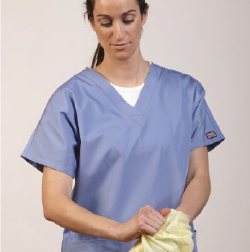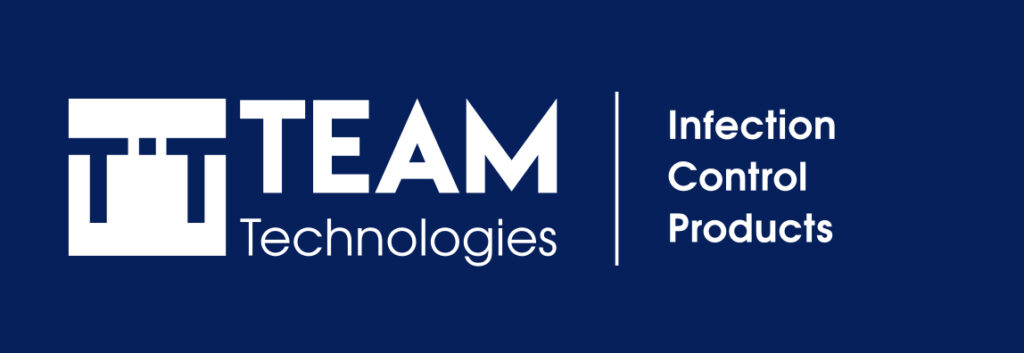
Understanding hazards and risk of exposure is the key to selecting the proper personal protection equipment (PPE). We offer a wide range of gowns to fit your facility’s needs.
The Centers for Disease Control and Prevention (CDC) guidelines for selecting the proper PPE can be accessed at
For basic infection control, this non-woven fabric bonds fibers together to form a single layer that is appropriate only for very minimal fluid exposure.
Strong and breathable, Spunbond/Meltblown/Spunbond (SMS) is a multi-layer fabric composed of inner layers of meltblown polypropylene between outer layers of Spunbond polypropylene that is ideal for extended wear. Light/medium weight SMS is appropriate for low amounts of fluid and heavy weight SMS may be appropriate for moderate contact with fluids.
Soft, spunbond polypropylene is coatedwith a layer of polyethylene (plastic) film.
A single layer of polyethylene (plastic) filmprovides protection at an affordable cost.
| ANSI/AAMI; PB70 Barrier Performance | Test Method | Test Definition | Requirements | Anticipated fluid exposure | |
|---|---|---|---|---|---|
| AAMI Level 1 | Water resistance: Impact penetration AATCC 42” | AATCC 42 | Measures the resistance of fabrics to the liquid penetration of water by impact | Water impact ≤ 4.5 g | Minimal fluid levels (some resistance to water spray) |
| AAMI Level 2 | Water resistance: Impact penetration AATCC 43 | AATCC 42 | Measures the resistance of fabrics to the liquid penetration of water by impact | Spray Impact ≤ 1.0 g | Low fluid levels (resistant to water spray and some resistance to water penetration under constant contact with increasing pressure) |
| Water resistance: Hydrostatic pressure AATCC27 | AATCC 27 | Measures the resistance of fabrics to the liquid penetration of water by impact under constant and increasing hydrostatic pressure | Hydrostatic Pressure ≥ 20 cm | ||
| AAMI Level 3 | Water resistance: Impact penetration AATCC 43 | AATCC 42 | Measures the resistance of fabrics to the liquid penetration of water by impact | Spray Impact ≤ 1.0 g | Moderate fluid levels (resistant to water spray and some resistance to water penetration under constant contact with increasing pressure) |
| Water resistance: Hydrostatic pressure AATCC27 | AATCC 27 | Measures the resistance of fabrics to the liquid penetration of water by impact under constant and increasing hydrostatic pressure | Hydrostatic Pressure ≥ 50 cm | ||
| AAMI Level 4 | ASTM F1671, Standard Test Method for Resistance of Materials Used in Protective Clothing to Penetration by Blood-Borne Pathogens Using PHI-X174 Bacteriophage Penetration as a Test System | ASTM F1671 | Measures the resistance of materials used in protective clothing to penetration by blood borne pathogens using a surrogate microbe under conditions of continuous liquid contact | Pass | Blood and viral penetration resistance (2psi) |
wwwn.cdc.gov/PPEInfo/Standards/Info/ANSI/AAMIPB70Class3
AAMI PB70: This standard is made up of 2 tests for Levels 1, 2, & 3: ASTM Spray Impact Penetration Test and Hydrostatic Head Test. For Level 4 the standard is made up of 1 test:ASTM1671, Viral Penetration of blood borne pathogens.
The Spray Impact Test is performed to determine if the product is protective or nonprotective. The Spray Impact Penetration Test measures the resistance of fabrics to liquid penetration by water spray impact. Results help predict barrier performance of the isolation gown’s critical zones and indicate how well the gown will perform when fluids fall or splash onto it.
The Hydrostatic Pressure Test result indicates the level of protection from 1-3. The Hydrostatic Head Test measures the resistance of fabrics to liquid penetration by water under constantly increasing hydrostatic pressure. Results help predict barrier performance properties of the isolation gown’s critical zones and indicate how well the gown will perform when fluid pressure is applied to it.
OSHA standard 29 CFR Part 1910.1030(d)(3)(i): Provision. When there is occupational exposure, the employer shall provide, at no cost to the employee, appropriate personal protective equipment such as, but not limited to, gloves, gowns, laboratory coats, face shields or masks and eye protection, and mouthpieces, resuscitation bags, pocket masks, or other ventilation devices. Personal protective equipment will be considered “appropriate” only if it does not permit blood or other potentially infectious materials to pass through to or reach the employee’s work clothes, street clothes, undergarments, skin, eyes, mouth, or other mucous membranes under normal conditions of use and for the duration of time which the protective equipment will be used
Isolation: For isolation gowns intended for use in isolation precaution applications, the critical zone shall comprise the entire gown, including the seams but excluding the cuffs, hems, and bindings, and shall have a barrier performance of at least Level 1.
Protective: Item of protective apparel designed to protect health care personnel and patients from the transfer of microorganisms and body fluids from exposure to the front and back of the wearer
Procedure: Non-sterile item designed to protect health care personnel and patients from the transfer of microorganisms and body fluids during procedures that do not require a surgical gown.
*ANSI/AAMI PB70:2022




Helpful Hints for Donning
1. Locate label at the top of the gown. Hold at neck and allow to unfold. The patented fold allows the
gown to unfold in the ideal position for donning.
2. Place head through apron style opening.
3. With thumbs facing upward, slide one arm at a time into sleeves through the thumb
loop design.
4. Pull the right side of the gown behind your back and then overlap the left.
5. Gently secure ties behind the back.
Please note that any article worn on the arms, wrists or hands such as a watch or ring,
could tear the gown. Please remove all adornments before donning the gown.
Helpful Hints for Removing
1. To remove, locate the base of the tie straps at hip and pull to release one at a time.
(Do NOT pull both sides at once as you risk aerosolization of contaminants on the gown).
2. Reach up to the shoulder, graps the gown and pull down. Repeat on the other side.
(Do NOT pull both sides at once as you risk aerosolization of contaminants on the gown).
3. Roll gown into itself removing gloves into the gown being careful to only touch the inside of the
gown once the gloves are removed.
4. Properly dispose of the gown
Reach out for more information

TEAM Technologies delivers superior healthcare solutions that protect, improve, and save lives. Our ONE TEAM philosophy means that we collaborate openly with our customers and TEAM members to provide the highest quality products and services. We are committed to complying with regulatory requirements, while continuously improving our processes to maintain an effective Quality Management System.
Copyright 2024 | ICP Medical | Privacy Policy | Web Design by Goebel Media
Category
Category
Category
Category
Category
Category
Category
Category
Category
Category
Category